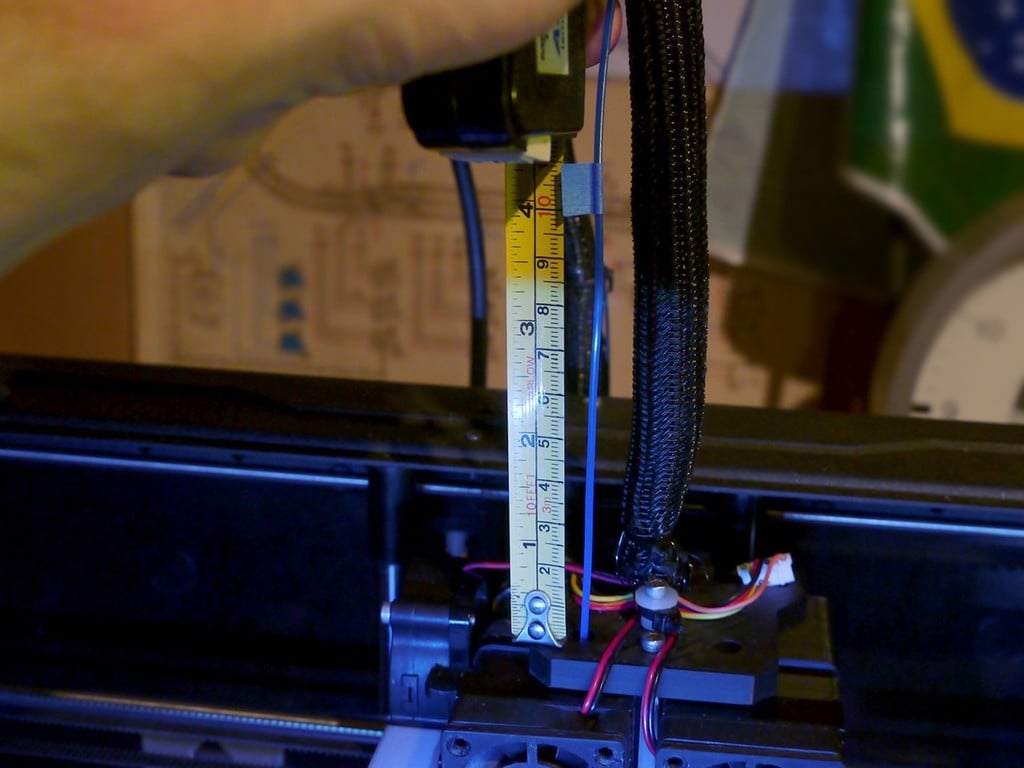
100mm extrusion calibration for FlashForge Creator Pro
thingiverse
These are ready-to-use X3G files for FlashForge Creator Pro and similar printers to perform calibration procedures explained on MatterHackers' site. The files instruct the printer to extrude 100 mm of filament exactly. Ideally this results in 100 mm of filament going into the extruder, but practically it's usually less or slightly more. To compensate during printing, an extrusion multiplier must be applied. **How to use** Do not load the filament you want to measure for the extrusion multiplier directly. Instead, cut a strand from the spool at least 260 mm long. Load this strand into the extruder without the guide tube so it sticks out from the top of the extruder carriage. You must have at least 200 mm of filament sticking out from the top of the carriage, preferably slightly more. Push the filament inside the hot-end tube but don't push it as deep as it can go. Next, hold the strand vertically and mark a reference point on it or take the end as the reference point. Measure the distance between the top of the carriage and this reference point. This distance must be at least 100 mm (preferably more). Keep the filament straight while measuring but don't stretch elastic filaments to avoid incorrect measurements. Write down this distance. There are two sets of files: regular and slow. The regular ones are suitable for common materials like PLA, ABS, or PETG. The slow ones are recommended for TPU or other soft filaments. Choose the x3g file from the appropriate set and desired extruder (left or right) and temperature, and 'print' it. Pick a temperature close to what you'll use for printing with this filament. The LCD display will prompt to press OK when the extruder is at temperature. When it's finished, measure the distance between the top of the carriage and the reference point again. Compare this new measurement to the original one to see if they deviate much. If they do, repeat the test with the 'slow' files. If you still get wildly varying results with the slow files, check extrusion temperature and ensure your extruder gears aren't clogged with filament remains. In theory, the test should be repeated for every different filament, but you can probably safely assume that different colors of the same material from the same brand will yield the same results. Mind that you cannot re-print the test files with your calculated multiplier. This would require making new X3G files, and it would be pretty pointless anyway if you correctly measured and calculated everything. It's not essential to get the extrusion multiplier correct to umpteen digits after the decimal point. In fact, from this test I found out that I had been under- or over-extruding certain filaments for a long time, yet my prints were accurate and reliable. In the end, use the multiplier that provides the best results in practice, not in theory. This method will only compensate for the difference in expected versus actual extruded length. As explained below, it does not compensate for incorrect filament diameter because that is not the purpose of the extrusion multiplier. Last but not least, do not keep extruding until the strand of filament disappears into the extruder and it runs out of material. Unless you're lucky and can push the strand down the tube with another strand, the only way to get out of this situation is to disassemble the extruder down to the hot-end, not my idea of fun. **Note about used material estimates** Some slicing programs, like Slic3r and PrusaSlicer at the time of this writing, will include the extrusion multiplier in their estimates of used material for a print. This is wrong. From the explanation below, it should be obvious that the only purpose of the EM is to correct for a mismatch between the length of filament the printer is expected to consume, and what it actually consumes. Once the multiplier is correctly configured, the printer will extrude exactly the length and weight of filament that can be calculated from the filament diameter and density, and nothing more. Please vote or comment on Slic3r issue #4087 to ask to fix this bug, and file a bug for other slicing programs if you notice they make this same mistake. If for some reason you want to deliberately over- or under-extrude, do not fiddle with the extrusion multiplier. Instead, respectively lower or raise the filament diameter in your slicing program.
With this file you will be able to print 100mm extrusion calibration for FlashForge Creator Pro with your 3D printer. Click on the button and save the file on your computer to work, edit or customize your design. You can also find more 3D designs for printers on 100mm extrusion calibration for FlashForge Creator Pro.
